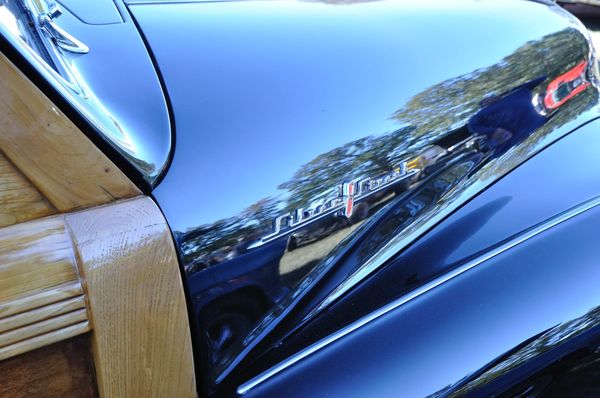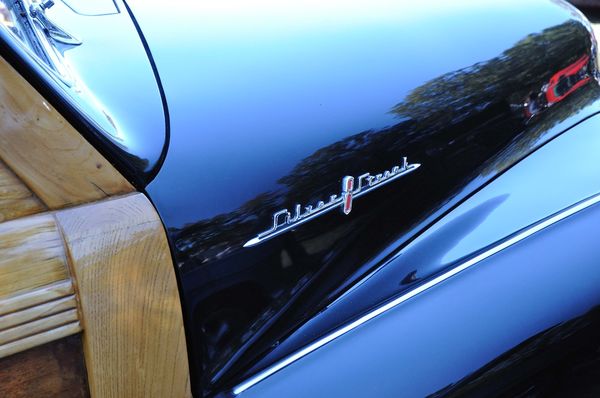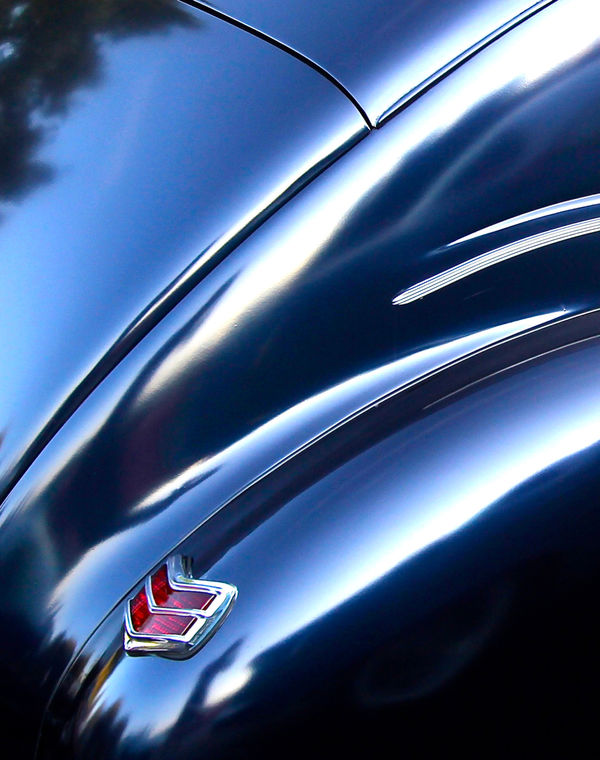Photographing a Car
Aug 1, 2018 18:25:49 #
Need some guidance on photographing design details of a car, without picking up reflections of my camera, my bony knees, the tripod and anything in my background. Where should light-source be, etc. I've never done this before and I thought it would be easy.
Thanks.
Thanks.
Aug 1, 2018 18:45:45 #
Someone who does a lot of car show photography told me that using a polarizing filter can reduce reflections on cars. I tried it. It cuts down on glare but reflections are still there. I sometimes go to the Rockabilly Hot Rod Rumble in Fredericksburg, VA. I took my polarizing filter with me and did these shots.
Aug 1, 2018 19:07:50 #
Back off. Use a wide-ish lens and crop, but putting your reflection on a highly curved section will make it less recognizable, even with a "normal" lens. Then take and use a PP such as LR to smooth out the bony knees, but you probably don't have to at this point.
This is about a 20% crop taken at 18mm on a Canon 60D/10-22mm combo. (an absolutely *great* lens, btw)
You can see me in there, three times, if you look carefully.
This is about a 20% crop taken at 18mm on a Canon 60D/10-22mm combo. (an absolutely *great* lens, btw)
You can see me in there, three times, if you look carefully.
Aug 1, 2018 19:23:11 #
Some years ago, I helped design a lighting set up for a New York City based studio that specialized in advertising photography for the automotive industry. They required a lighting design that would do exactly what you are describing, that is, accentuating the lines of the body design withou excessive reflections from other sources. I know you are not asking about studio work but there is a definite connection that you can apply to natural light in out-of-doors situations.
That studio had a huge cyclorama and we created a giant softbox by bouncing some very powerful strobes off a white ceiling and diffusing the light with an enormous sheet of material made of several panels of sail cloth sewn together. The cars were place so that the main light source was, of course, overhead but striking the car slightly form the back. This would accentuate the lines by placing highlights on the roof, the top of the fenders, and the outline the outline of the trunk etc. The middle tones and shadows were on the sides the rocker-panels and the lower body. The extraneous light and a few reflectors were enough to fill the shadows nicely. The wall in back of the photographer was painted black so there were no reflection from that surface. 4x8 panels of Foam-Core boards were used to fill or add reflections where they were needed.
Don't worry about eliminating every single reflection- if all the highlight are negated, the image will be flat. You need to "sculpt" the shape of the car by creating dimension which consists of highlights and shadows- you just want the highlight in the right places.
I don't know what the purposes or usage is of your eventual images. I have use the following method for advertising, antique car collectors, and a supplier of body and fender shop supplies.
The best way to simulate this kind of lighting is to photograph the cars on a hazy or overcast day where the skylight is diffuse and even. On a bright day, open shae or an area that is shared by an overhang may work out. You must avoid spotty or dappled light that may occur under a tree. On brighter days, more dramatic and "romantic" car shots are created just after sunrise of just before sunset when the light is harsher BUT more directional and my also work well on the lines of the car.
Of course, this technique only apples if you have control over the time and place of the shoot. The car needs to be brought to the chosen location and moved incrementally into the light pattern. At car shows and similar events, it usually hard to isolate the cars and place them specifically for the best lighting.
As for extraneous reflections, you may want to consider a CPL (Circular Polarizing) filter. The trick is to rotate the filter and place the car so that the DESIRED aforementioned reflections are not minimized or eliminated and the unwanted reflection are subdued or eliminated. Some reflections in windows are natural and acceptable.The polarizer will not eliminate reflections from "chrome" trim or othere metallic features.
Watch your backgrounds- make certain that there is nothing sticking up behind the car- trees- utility poles, etc. You don't want anythg protruding into the composition that will distract for the lines. Use a normal or slightly longer that normal lens to avoid foreshortening, elongation or compression of the perspective- avoid distortion! Shoot at different angles at various levels and study the lines to select the best camera positions.
Make sure the cars a clean and tidy. Use a tripod if you can. Focus carefully and make sure you have ample depth of field- you want sharp results.
I hope this helps.
That studio had a huge cyclorama and we created a giant softbox by bouncing some very powerful strobes off a white ceiling and diffusing the light with an enormous sheet of material made of several panels of sail cloth sewn together. The cars were place so that the main light source was, of course, overhead but striking the car slightly form the back. This would accentuate the lines by placing highlights on the roof, the top of the fenders, and the outline the outline of the trunk etc. The middle tones and shadows were on the sides the rocker-panels and the lower body. The extraneous light and a few reflectors were enough to fill the shadows nicely. The wall in back of the photographer was painted black so there were no reflection from that surface. 4x8 panels of Foam-Core boards were used to fill or add reflections where they were needed.
Don't worry about eliminating every single reflection- if all the highlight are negated, the image will be flat. You need to "sculpt" the shape of the car by creating dimension which consists of highlights and shadows- you just want the highlight in the right places.
I don't know what the purposes or usage is of your eventual images. I have use the following method for advertising, antique car collectors, and a supplier of body and fender shop supplies.
The best way to simulate this kind of lighting is to photograph the cars on a hazy or overcast day where the skylight is diffuse and even. On a bright day, open shae or an area that is shared by an overhang may work out. You must avoid spotty or dappled light that may occur under a tree. On brighter days, more dramatic and "romantic" car shots are created just after sunrise of just before sunset when the light is harsher BUT more directional and my also work well on the lines of the car.
Of course, this technique only apples if you have control over the time and place of the shoot. The car needs to be brought to the chosen location and moved incrementally into the light pattern. At car shows and similar events, it usually hard to isolate the cars and place them specifically for the best lighting.
As for extraneous reflections, you may want to consider a CPL (Circular Polarizing) filter. The trick is to rotate the filter and place the car so that the DESIRED aforementioned reflections are not minimized or eliminated and the unwanted reflection are subdued or eliminated. Some reflections in windows are natural and acceptable.The polarizer will not eliminate reflections from "chrome" trim or othere metallic features.
Watch your backgrounds- make certain that there is nothing sticking up behind the car- trees- utility poles, etc. You don't want anythg protruding into the composition that will distract for the lines. Use a normal or slightly longer that normal lens to avoid foreshortening, elongation or compression of the perspective- avoid distortion! Shoot at different angles at various levels and study the lines to select the best camera positions.
Make sure the cars a clean and tidy. Use a tripod if you can. Focus carefully and make sure you have ample depth of field- you want sharp results.
I hope this helps.
Aug 1, 2018 22:20:15 #
mffox wrote:
Need some guidance on photographing design details of a car, without picking up reflections of my camera, my bony knees, the tripod and anything in my background. Where should light-source be, etc. I've never done this before and I thought it would be easy.
Thanks.
Thanks.
Your light source will not usually be significant. The question is what will be reflected! How it is lighted only counts if that area can be made totally dark.
Do a Google search on "angle incidence reflection" to get many sources of information about your question. Your circumstances will be far more complex though because the discussions will assume a flat reflecting surface and you are most often going to have a curved surface. Curvature means it will not be just one angle, but rather a range of angles to be concerned with.
The easy question is how to keep the photographer out of the reflection: never be positioned perpendicular to any reflective plane on the object being photographed! But then you have to consider what does get reflected, and be positioned where it is not an obectionable reflection.
Aug 2, 2018 06:55:05 #
I'm with E.L.. Shapiro: A circular polarizing filter is my best friend at car shows. I don't have any control over the weather, so I try to minimize reflections while still capturing polish and sheen.
Aug 2, 2018 08:12:59 #
Nothing to contribute other than a thank-you to both ELS and Apaflo for such interesting and helpful contributions. I shall give this a go myself!
Aug 2, 2018 08:24:49 #
Apaflo is correct. When photographing highly polished surfaces, wanting to control the intensity of diffuse and specular highlights and minimize or negate distracting reflections, the understanding of ANGLE OF INCIDENCE theory is essential.
The angle of incidence is equal to the angle of reflection. Of corse this can be calculated mathematicly and geometricly, however, once you have the theory in mind, in actual practice you will learn to place the subject and the camera to effectively address the subject and situation at hand as well as the effect you wish to achieve.
Of course, the theory holds true regardless of the light source or the quality, softness or hardness, of the light. I recommded more diffusion in that, with an object as large and shiney as a car and what with highly polished trim and the reflective properties of window glass, a softer and broader source will be less problematic.
The CPL filter is handy and applicable but it is not a cure all. Its use interfaces with the angle of incidence. In certain cases it will improve color saturation and dramatze foliage and sky-scapes in the background. You must, however, be sure not to eliminate the highlights necessary to accentuate the lines of the car.
The angle of incidence is equal to the angle of reflection. Of corse this can be calculated mathematicly and geometricly, however, once you have the theory in mind, in actual practice you will learn to place the subject and the camera to effectively address the subject and situation at hand as well as the effect you wish to achieve.
Of course, the theory holds true regardless of the light source or the quality, softness or hardness, of the light. I recommded more diffusion in that, with an object as large and shiney as a car and what with highly polished trim and the reflective properties of window glass, a softer and broader source will be less problematic.
The CPL filter is handy and applicable but it is not a cure all. Its use interfaces with the angle of incidence. In certain cases it will improve color saturation and dramatze foliage and sky-scapes in the background. You must, however, be sure not to eliminate the highlights necessary to accentuate the lines of the car.
Aug 2, 2018 08:28:50 #
mffox wrote:
Need some guidance on photographing design details of a car, without picking up reflections of my camera, my bony knees, the tripod and anything in my background. Where should light-source be, etc. I've never done this before and I thought it would be easy.
Thanks.
Thanks.
Did you really think that it was going to be easy? Interesting.
Anyway, I like this guy’s work, which most likely means that Apaflo is going to make a comment that this guy would also be laughed out of Alaska and doesn’t know what he is doing.
But here is his website, hopefully you can get some ideas from his shots.
https://gfwilliams.net
Aug 2, 2018 08:41:51 #
mffox wrote:
I used to shoot car commercials. One of the things we did a lot of was to shoot in the early morning so the sun would be low and reflecting off the car at a low angle and towards the camera. What this means is say the car is at the center of a 160 degree arc. The sun and camera would be at the two opposing ends. Now that is somewhat unlikely at a car show. People would likely be milling about where the sun should be, but you wouldn't likely see yourself in the reflection. The other thing we did was to occasionally use dulling spray on the reflection. Again, not a good solution for a car show.Need some guidance on photographing design details of a car, without picking up reflections of my camera, my bony knees, the tripod and anything in my background. Where should light-source be, etc. I've never done this before and I thought it would be easy.
Thanks.
Thanks.
Aug 2, 2018 09:56:29 #
WaM_Photo
Loc: Sandia Park, New Mexico
I look for reflections when photographing classic cars and lowriders. I think it adds interest to the image. I understand about not wanting to have your (the photographer's) image in the shot. If it's unavoidable, I will try to hide myself somewhere in the image. I find clouds, pavement and even other people reflected in the shot makes the image more interesting. Distance from your subject and cropping for details will make the image.
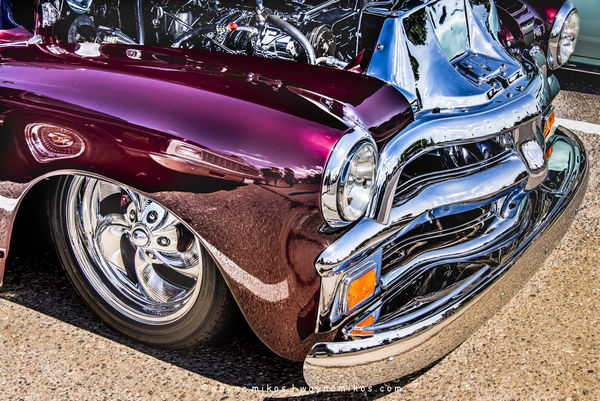
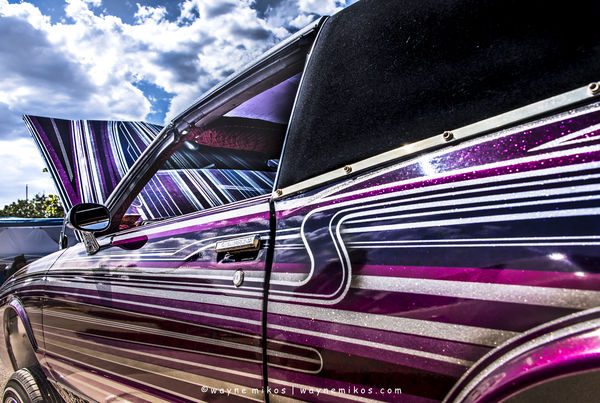
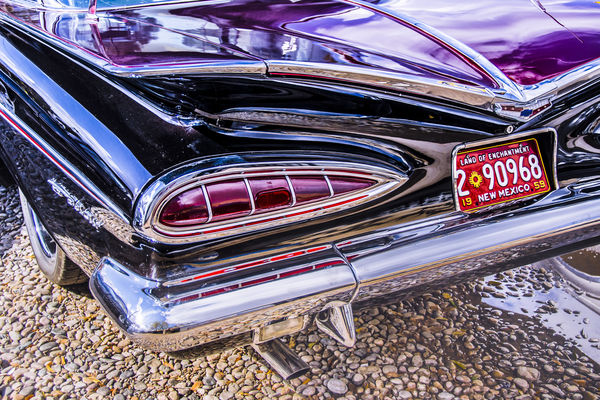
Aug 2, 2018 10:42:10 #
tdekany wrote:
Did you really think that it was going to be easy? Interesting.
Anyway, I like this guy’s work, which most likely means that Apaflo is going to make a comment that this guy would also be laughed out of Alaska and doesn’t know what he is doing.
But here is his website, hopefully you can get some ideas from his shots.
https://gfwilliams.net
Anyway, I like this guy’s work, which most likely means that Apaflo is going to make a comment that this guy would also be laughed out of Alaska and doesn’t know what he is doing.
But here is his website, hopefully you can get some ideas from his shots.
https://gfwilliams.net
GFW’s images are certainly very attractive, but they do seem to present a satin finish generally rather than a gloss.
Aug 2, 2018 12:00:08 #
Sbrown2813
Loc: Grayson, Ga
I attend a lot of car shows due to my husbands business, photography is a hobby for me. I like the reflections in the car photos, as long as it's not the photographer.
Aug 2, 2018 12:25:46 #
magnetoman wrote:
GFW’s images are certainly very attractive, but they do seem to present a satin finish generally rather than a gloss.
I posted it to give the op a clue as far as composition time of day etc.
Basically, what makes a good car photo. By default, at car shows you’ll end up with mostly snapshots.
Best not to learn from snapshots.
Many of his photos are glossy, at least on ny Retina display.
Aug 2, 2018 21:27:23 #
TonyBot,
I have been spending some time looking at ultrawides. Concensus seems to be that while the Canon 10-22 is a good lens, the 10-18 performs a bit better in some ways but when you figure in the price difference, the 10-18 is the wisest, most cost efficient choice. Your comments?
Thanks,
Photodoc16
I have been spending some time looking at ultrawides. Concensus seems to be that while the Canon 10-22 is a good lens, the 10-18 performs a bit better in some ways but when you figure in the price difference, the 10-18 is the wisest, most cost efficient choice. Your comments?
Thanks,
Photodoc16
If you want to reply, then register here. Registration is free and your account is created instantly, so you can post right away.


